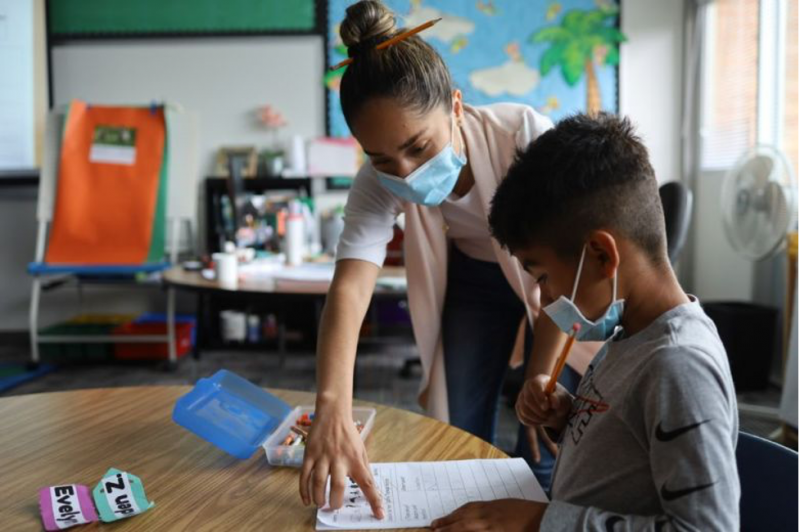It’s possible that the 50,000 struggling students who received tutoring last year would be doing much worse without the extra instruction. Or, maybe it’s taking a while for schools to set up new tutoring programs, and it’s not yet showing big results. Brown University’s Matthew Kraft is studying tutoring efforts in Nashville to help answer these questions, but methodical research is slow.
“We need to be prepared for underwhelming results from tutoring operations,” said Kraft, who believes it will take time for schools to figure this out. “Changing educational systems at scale is hard.”
Meanwhile, tutoring companies are reporting impressive but unverified gains from students who are receiving frequent tutoring sessions. It can be unclear whether the students who show up day after day are more motivated and would have done just as well without the tutoring. While we wait for more rigorous results that compare students who did and didn’t receive tutoring – apples to apples – one troubling issue is already emerging: low participation or attendance rates.
In one large city, Amplify contracted to give almost 1,200 students tutoring sessions three times a week with a tutor delivering sessions over a video call, similar to Zoom. More than 100 kids never logged in to connect with a tutor online. Only 200 students – fewer than 20 percent – received at least two sessions a week throughout the school term. More than 80 percent received less, often far less.
I talked to a school administrator in another school district south of Fort Worth, Texas, who assigned 375 third graders across all 15 of his elementary schools to use Amplify tutors in the spring term. The Crowley school district especially wanted its lowest achieving third graders to receive tutoring because their first and second-grade years were so disrupted by the pandemic when they were just learning to read.
Tutoring sessions were supposed to take place during the school day, during a special half-hour class dedicated to extra catch-up instruction, but teachers had discretion over whether to get the computers out to connect students with their remote tutors. Overall, students attended only 46 percent of the sessions that were supposed to take place.
“Attendance has been a challenge,” said Crowley chief academic officer Nicholas Keith. “Some campuses bought into it. But it was hard for some to find time for the tutoring component.”
Teachers may have been hesitant to put their students in front of screens, Keith explained, and wanted to work with students directly themselves. At the same time, the district was plagued with many teacher absences as the virus variants surged through their community and substitute teachers often didn’t know they were supposed to set up the computers for tutoring.
Next year, Keith said he plans to continue the online tutoring only at the schools that were making good use of it. In some schools, more than 60 percent of the students attended on a regular basis and the teachers noticed progress in students’ reading abilities, Keith said.
Meanwhile, Saga, which tutored more than 6,000 ninth graders in math during the 2021-22 year, reported that students attended two thirds of their in-person daily sessions, on average, with attendance rates ranging from a high of 87 percent in Washington, D.C., to a low of 49 percent in Providence, Rhode Island. Among the 62 percent of its students who received at least 80 hours of tutoring, 87 percent passed their math classes this past spring.
Saga’s tutoring is a scheduled course during the school day called “math lab,” without other competing instructional activities at the same time. “The attendance rate is the same as a student’s school attendance rate,” said AJ Gutierrez, a co-founder of Saga.
An outside research firm, Mathematica, is currently studying Saga’s tutoring results during the pandemic, analyzing the tradeoff between larger tutoring groups and how much students gain from tutoring. Larger groups are more economical and reach more students.
The Tennessee Department of Education said it was seeing much lower attendance rates for tutoring sessions scheduled before and after school. Most schools, however, have opted to provide tutoring during the regular school day, the department said. “Tutors often pull students from their classrooms to ensure that students who are at school receive their tutoring session,” a spokesperson for the department explained by email.
Saga’s Gutierrez says he’s heard stories of after-school and summer programs failing to lure students to tutoring sessions with gift cards, movie passes and food. “I know of a principal in North Carolina who did everything above and more (i.e. added extra curricular activities) to get 100 students in his school to attend summer tutoring, but only ended up with 21,” Gutierrez said by email.
Tutoring was a big component of the 2001 No Child Left Behind law that aimed to lift the achievement of low-income children. But between poorly trained tutors and outright embezzlement scandals, it was not a success. This time around, many schools are trying to improve tutoring quality. But attendance is uneven.
One suggestion to help tutoring deliver on its promise comes from Bart Epstein, president of the EdTech Evidence Exchange, a nonprofit that aims to help schools make better decisions in buying education technology. He is also a former executive at tutor.com, a tutoring company. “No school district should be paying for tutoring if kids aren’t showing up,” Epstein said. “That’s ridiculous and wrong for so many reasons. Anyone who negotiates a contract that results in paying a tutoring organization for service for 1,100 students when only 200 receive service should be ashamed of themselves.”
“If you want tutoring companies to get kids to show up,” Epstein said, “structure their contracts so that they have the incentive to make that happen, even if it requires tutoring companies to hire caseworkers and social media people and customer service people who call parents, and meet with kids to find out what they need.”


